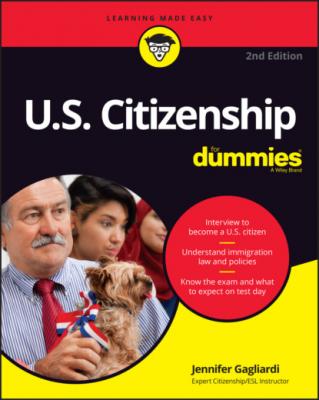ТОП просматриваемых книг сайта:
U.S. Citizenship For Dummies. Jennifer Gagliardi
Читать онлайн.Название U.S. Citizenship For Dummies
Год выпуска 0
isbn 9781119766896
Автор произведения Jennifer Gagliardi
Издательство John Wiley & Sons Limited
travel.state.gov/content/travel/en/legal/visa-law0/visa-bulletin.html.
Fourth preference: Special immigrants
Special immigrants receive 7.1 percent of the yearly worldwide limit. Thirteen subgroups qualify as special immigrants, the most notable of which is the religious worker special immigrant. Other special immigrants include certain juveniles and battered spouses, certain overseas employees or retirees of the U.S. government, certain members of the U.S. armed forces, certain current and former employees of the Panama Canal Company, retired employees of international organizations, and certain dependents of international organization employees.
The religious worker category receives 5,000 of the allotted special immigrant visas. Religious workers are those who will work for a religious denomination that has a bona fide nonprofit religious organization in the United States and who are coming to work as ministers of religion, to work in a professional capacity in a religious vocation, or to work in a religious occupation. The worker must have been a member of this religious denomination and must have worked for the denomination for at least two years before applying for admission to, or adjustment of status in, the United States.
Fifth preference: Immigrant investors
Employment creation investors receive 7.1 percent of the yearly employment visa total. To qualify in this category, be prepared to invest about $1.8 million (or the U.S. dollars equivalent in your currency), depending on the employment rate in the geographical area where you will set up business. Your U.S. enterprise will also need to create at least ten new full-time jobs for U.S. citizens, permanent resident aliens, or other lawful immigrants, not including you and your family.
Discovering Other Ways to Qualify for Permanent Residence
What if you don’t qualify for family- or employment-based immigration? Are there other ways you can gain lawful permanent residence in the United States? Thankfully, yes, but only under some specific conditions and restrictions.
Immigrating through asylum
If you are a potential immigrant already in the United States (legally or illegally) or you’re applying for admission at its borders, you may petition the government for asylum by demonstrating you have a “well-founded fear of persecution” in your home country, based on race, religion, nationality, membership in a social group, or political opinion. Proving you belong in one of these protected categories can be complicated, because the legal definitions of well-founded fear and persecution are vague at best. We strongly recommend you seek the advice of a qualified immigration attorney. (You can find out more about hiring qualified and ethical help in Chapter 7.)
In most cases, if you’re seeking to enter the United States and you indicate a desire to seek asylum, the Directorate of the Department of Homeland Security (DHS) places you in expedited removal, where an asylum officer from the USCIS determines whether you have a credible fear. If the asylum officer determines that you do have a credible fear, you’re allowed to apply before an immigration judge (who is part of the Department of Justice).
Although the USCIS won’t grant work authorization for the first 150 days after the filing of an asylum claim (unless, of course, asylum is granted in the meantime), work authorization is automatic for cases on the docket longer than 180 days — as long as you’re not the one who caused the delay.
A copy of your USCIS or DHS Arrival-Departure Record (Form I-94), obtained when you first entered the country
A clear copy of the letter granting your asylum status
Any documentation of the conditions being removed (if you were originally granted conditional asylum)
Copies of documents covering large periods of time, such as apartment leases, school enrollment records, or letters of employment
Looking for safe refuge
Benefits the U.S. government provides for qualified refugees include
A no-interest travel loan to the United States
Eight months of Refugee Cash Assistance (RCA) and Refugee Medical Assistance (RMA)
Food stamps to help pay for groceries
Housing assistance, furnishings, food, and clothing
A Social Security card
School registration for children
Referrals for medical appointments and other support services
Employment services
Case management through community-based nonprofit organizations
Adjustment of status from refugee to lawful permanent resident for refugees who have been physically present in the United States as refugees for a total of at least one year prior to filing for adjustment (see “Immigrating through asylum” earlier in this chapter for more information about documenting your presence).

